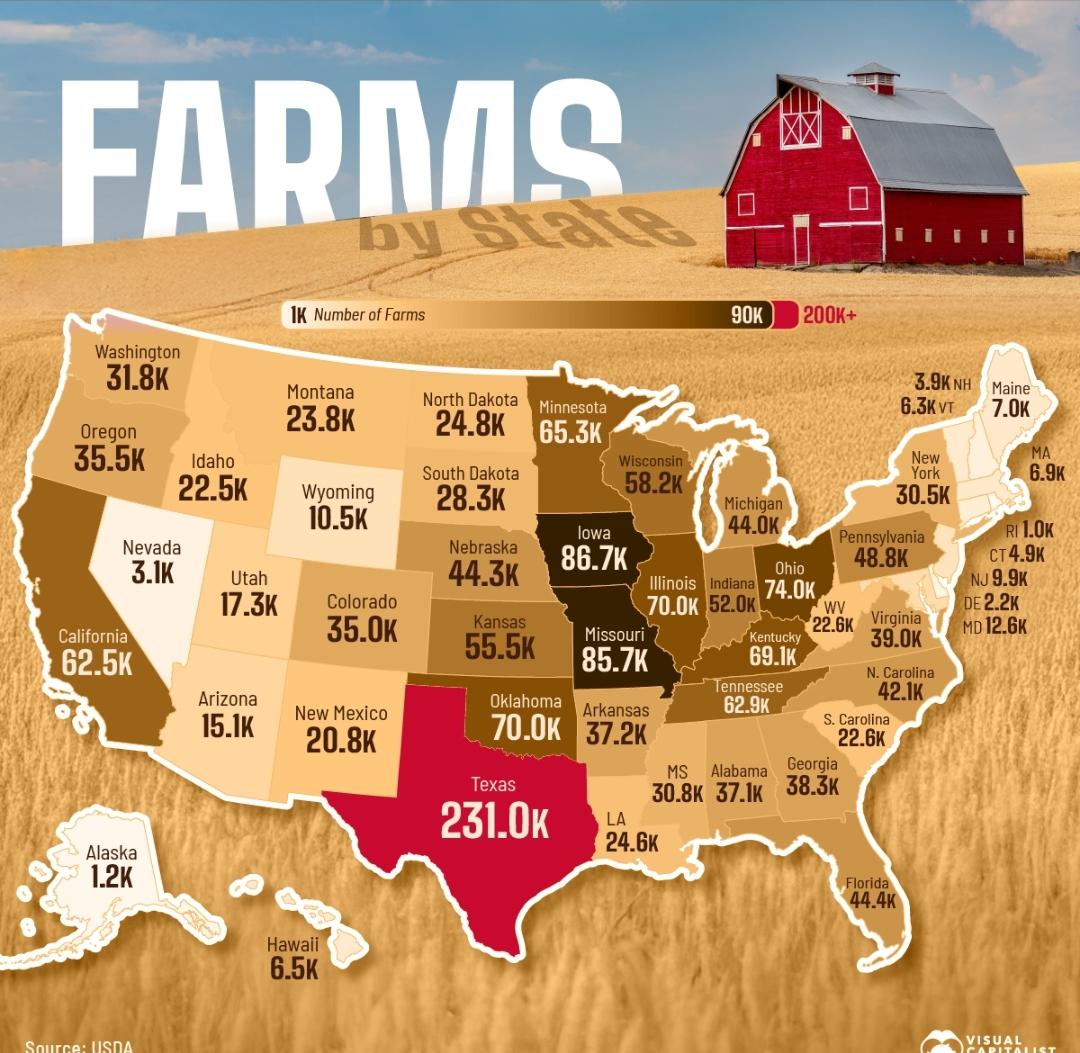Farms in the USA Map


Marcus Rodriguez
Historical Geography Expert
Marcus Rodriguez specializes in historical cartography and geographic data analysis. With a background in both history and geography, he brings unique...
Geographic Analysis
What This Map Shows
The "Farms in the USA" map provides a comprehensive overview of the agricultural landscape across the United States, highlighting not just the sheer number of farms but also the distribution and types of farming operations. With a staggering 1.88 million farms scattered throughout the country, this visualization reveals the vast agricultural tapestry that contributes significantly to the nation's economy and culture. As we delve into this topic, it’s essential to understand the implications of where these farms are located, what they produce, and how they shape local and national identities.
Deep Dive into Farming in the USA
Farming has always been an integral part of American life. The United States, with its diverse climates and geographies, supports a wide range of agricultural practices. Interestingly, Texas stands out as a key player in this arena, boasting the highest number of farms—231,000 to be exact. This includes a significant number of ranch-style operations that focus on cattle and hay production. Such farms tend to be smaller than the vast single-crop farms found in other regions. This smaller size contributes to Texas's high farm count, as ranchers often manage multiple parcels of land.
In terms of land area dedicated to farming, Texas also leads the nation with an astounding 125 million acres of farmland. This is a significant portion of the total agricultural land in the U.S., which encompasses a wide variety of crops and livestock. Following Texas, Montana and Kansas hold substantial farmland as well, with 57.4 million acres and 44.8 million acres respectively.
What’s fascinating is how different regions specialize in various agricultural products. For instance, California is renowned for its fruits, nuts, and vegetables, while the Midwest, often referred to as the "Corn Belt," is the heart of corn and soybean production. Each of these areas has developed unique farming techniques that cater to their specific environmental conditions, from irrigation practices in arid regions to crop rotation systems in more fertile areas.
Moreover, farming is not just about the quantity of farms or land; it also involves the economic impact these operations create. In 2020, agriculture contributed approximately $1.1 trillion to the U.S. economy, representing about 5% of the Gross Domestic Product (GDP). This underscores the essential role that farms play not only in food production but also in sustaining jobs and supporting local economies.
Regional Analysis
When breaking down the farming landscape by region, several key distinctions emerge. The Southern states, including Texas, Florida, and Georgia, often focus on livestock and cotton production, benefiting from a warmer climate that supports year-round farming. Conversely, the Northern states, particularly in the Midwest, are more focused on grain production, with expansive fields of corn and soybeans dominating the landscape.
In the Pacific Northwest, farms are often smaller and more diverse, with a strong emphasis on fruits, vegetables, and sustainable practices. For example, Oregon is well-known for its vineyards and berry farms, while Washington excels in apple production. Meanwhile, states like Iowa and Illinois have some of the highest yields per acre due to rich, fertile soil and advanced agricultural technologies.
The Northeast, while not as agriculturally dominant as other regions, still plays a crucial role in dairy farming, particularly in states like Vermont and New York. Interestingly, this area has seen a resurgence in small-scale and organic farms, reflecting a growing trend towards sustainable farming practices.
Significance and Impact
Understanding the distribution of farms across the U.S. is crucial for several reasons. First, it sheds light on food security and the importance of local farming in sustaining communities. As the global population continues to rise, the demand for food is expected to increase significantly. This puts pressure on farms to produce more while also adopting sustainable practices to protect the environment.
Moreover, the current trends in farming, such as the rise of organic farming and the implementation of technology in agriculture, are shaping the future of food production. With the increasing awareness of climate change, many farmers are also exploring innovative methods to reduce their carbon footprint and conserve resources.
In conclusion, the "Farms in the USA" map is more than just a visualization of numbers; it represents the backbone of American agriculture and its diverse practices. Each farm tells a story of tradition, innovation, and resilience, crucial for understanding not only where our food comes from but also how it shapes our economy and culture. As we continue to navigate the complexities of modern agriculture, it's essential to appreciate the role that these farms play in our everyday lives and the future of food production in the United States.
Visualization Details
- Published
- October 12, 2025
- Views
- 42
Comments
Loading comments...